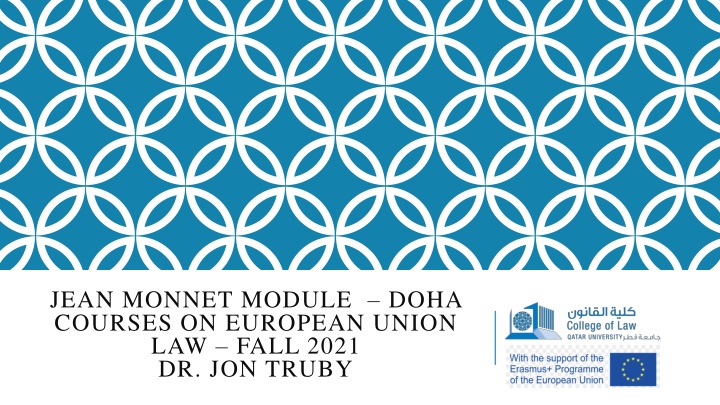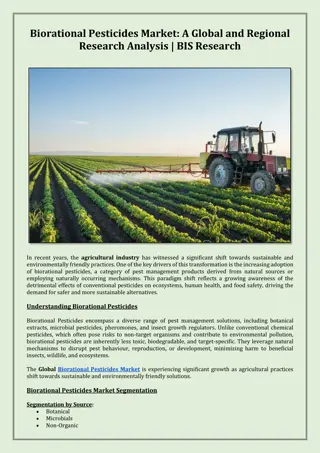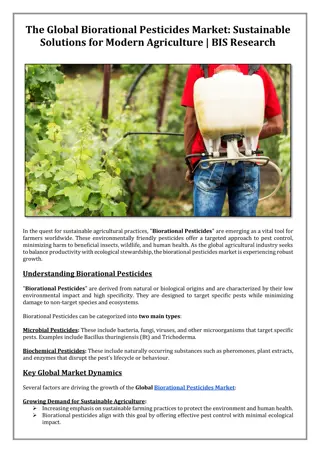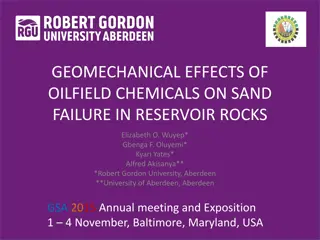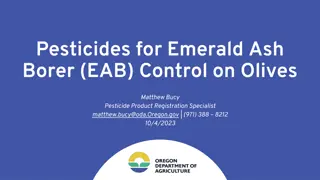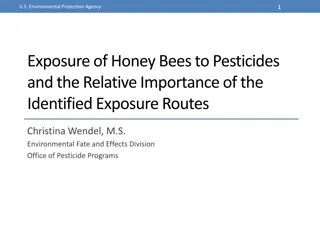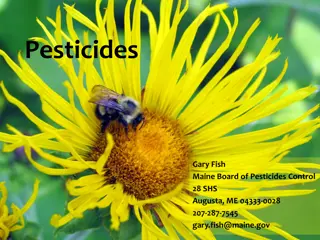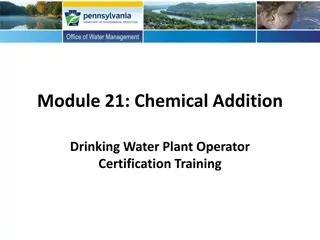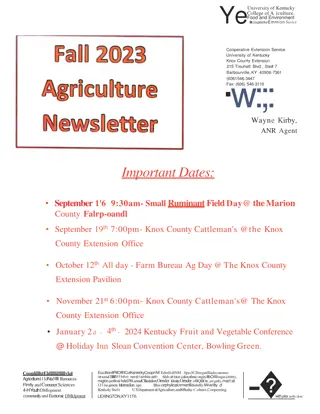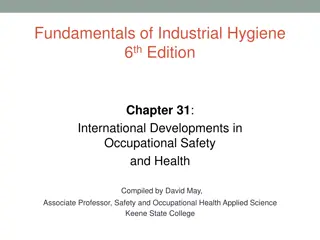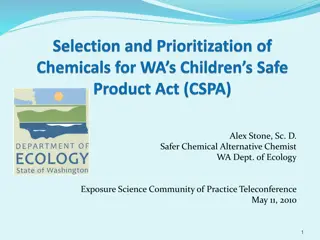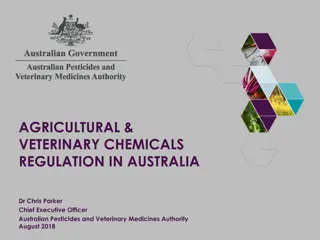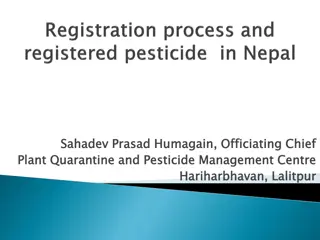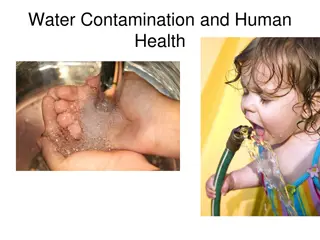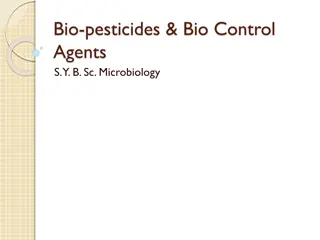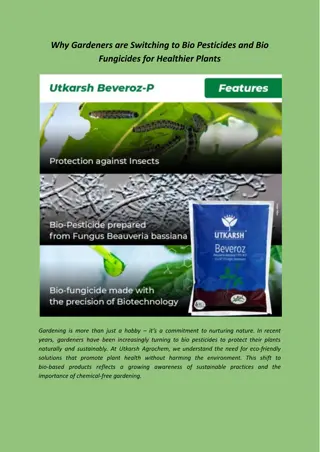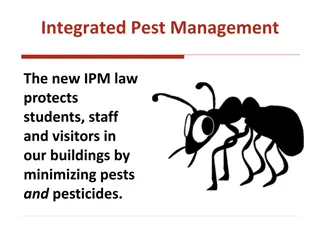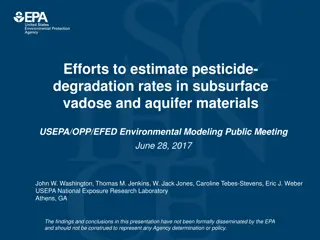EU Chemicals and Pesticides Legislation Overview
The EU Chemicals and Pesticides legislation aims to protect human health and the environment, governing the marketing, use, and restrictions on hazardous substances. The REACH Regulation plays a crucial role in regulating dangerous chemicals, promoting sustainable development, and shifting the burden of risk assessment to companies. The European Chemicals Agency manages the technical aspects of REACH, with industries required to register substances meeting specific criteria by set deadlines. The legislation is evolving to align with sustainability, farm-to-fork, and biodiversity strategies, emphasizing safety and trade facilitation.
Download Presentation

Please find below an Image/Link to download the presentation.
The content on the website is provided AS IS for your information and personal use only. It may not be sold, licensed, or shared on other websites without obtaining consent from the author.If you encounter any issues during the download, it is possible that the publisher has removed the file from their server.
You are allowed to download the files provided on this website for personal or commercial use, subject to the condition that they are used lawfully. All files are the property of their respective owners.
The content on the website is provided AS IS for your information and personal use only. It may not be sold, licensed, or shared on other websites without obtaining consent from the author.
E N D
Presentation Transcript
JEAN MONNET MODULE DOHA COURSES ON EUROPEAN UNION LAW FALL 2021 DR. JON TRUBY
Introduction EU chemicals and pesticides legislation aims to protect human health and the environment and to prevent barriers to trade. It consists of rules: -Governing the marketing and use of particular categories of chemical products -A set of harmonised restrictions on the placing on the market and use of specific hazardous substances and preparations -Rules governing major accidents and exports of dangerous substances.
Introduction Under the term pesticides are grouped substances used to suppress, eradicate and prevent organisms that are considered harmful. They include biocidal products and plant protection products (PPPs). The most important achievement at EU level is the REACH Regulation, which regulates the registration, evaluation and authorisation of dangerous substances and the restrictions applicable to them. Under the European Green Deal and particularly the new chemicals for sustainability , farm to fork and biodiversity strategies, EU legislation on these issues will be revised in the near future.
Registration, Evaluation, Authorisation and Restriction of Chemicals (REACH) The regulation established a new legal framework to regulate the development and testing, production, placing on the market and use of chemicals and replacing around 40 previous legislative acts. The aim of the REACH Regulation is to provide better protection for humans and the environment from possible chemical risks and to promote sustainable development. REACH introduced a single system for all chemicals and transferred the burden of proof concerning the risk assessment of substances from public authorities to companies.
Registration, Evaluation, Authorisation and Restriction of Chemicals (REACH) The European Chemicals Agency (ECHA), established under this regulation and based in Helsinki, is responsible for managing the technical, scientific and administrative aspects of REACH, and for ensuring consistency in its application. November 2010 was the first deadline for industries to register: - (i) all substances at volumes of 1 000 tonnes per year (tn/y) or more; - (ii) substances that are highly toxic to the aquatic environment, at volumes of 100 tn/y or more; - (iii) the most hazardous substances, whether carcinogenic, mutagenic or reprotoxic (CMRs), produced or imported at volumes of 1 tn/y or more.
Registration, Evaluation, Authorisation and Restriction of Chemicals (REACH) In 2013, the Commission published a review of the REACH Regulation in which it concluded that REACH does not require any changes to its enacting terms, even though progress could be made in reducing the financial and administrative burden on industries and finding alternative methods to animal testing. In 2017, the Commission conducted a second evaluation under the Regulatory Fitness and Performance Programme (REFIT), the results of which were published in COM(2018)0116. The evaluation concludes overall that REACH is effective, but opportunities for further improvement, simplification and burden reduction have been identified, which can be achieved by delivering the actions outlined in the report.
Registration, Evaluation, Authorisation and Restriction of Chemicals (REACH) The Commission published a new chemicals strategy for sustainability on 14 October 2020. It is part of the EU s zero pollution ambition, which is a key commitment of the European Green Deal. The strategy includes a revision of the REACH Regulation: - Prohibiting the use of the most harmful chemicals in consumer products such as toys, childcare articles, cosmetics, detergents, food contact materials and textiles, unless proven to be essential for society - Ensuring that all chemicals are used more safely and sustainably.
Classification, Packaging and Labelling In order to enhance the level of protection of human health and the environment, the same criteria for identifying, and labels for describing, chemical hazards should be used throughout the EU and the world. Adopted in 2008, Regulation (EC) No 1272/2008 on classification, labelling and packaging of substances and mixtures (CLP) was introduced to align the EU system to the UN Global Harmonised System (GHS). The earlier directives on dangerous substances and preparations were repealed in June 2015.
Export and Import of Dangerous Substances EU rules on the export and import of dangerous chemicals were defined in Regulation (EU) No 649/2012, which aimed to promote shared responsibility and cooperative efforts in the international movement of hazardous chemicals, and to implement the Rotterdam Convention on the Prior Informed Consent (PIC) Procedure for Certain Hazardous Chemicals and Pesticides in International Trade. The PIC procedure consists in sharing information on toxic chemicals and awaiting a country s explicit agreement before exporting the product in question.
Major Accidents The Seveso Directive (82/501/EEC) aimed to prevent major accidents such as fires and explosions and to limit the consequences of those that do occur by requiring safety reports, emergency plans and the provision of information to the public. In 1996, the Seveso II Directive (96/82/EC) on the control of major accident hazards involving dangerous substances introduced new requirements relating to safety management systems, emergency planning and land-use planning, and strengthened provisions on inspections carried out by Member States.
Major Accidents In the light of a number of serious industrial accidents (in Toulouse, France; Baia Mare, Romania; and Enschede, the Netherlands), and on the basis of studies on carcinogens and substances dangerous for the environment, the scope of the Seveso II Directive was extended by Directive 2003/105/EC. The Seveso III Directive (2012/18/EU) was published in July 2012 after being approved by Parliament and the Council. It takes account of new UN-agreed international classifications of substances that allow better risk evaluation and handling of substances.
Sustainable Use of Pesticides Substances used to suppress, eradicate and prevent organisms that are considered harmful are grouped under the term pesticides . The term includes both PPPs (used on plants in agriculture, horticulture, parks and gardens) and biocidal products (used in other applications, for example, as a disinfectant or to protect materials). In 2009, a Pesticides Package was adopted, consisting of: - Directive on the sustainable use of pesticides (SUD); - Regulation on the placing on the market of PPPs; - Regulation (EC) concerning statistics on pesticides.
Sustainable Use of Pesticides Directive 2009/128/EC required the Member States to adopt national action plans (NAPs) for the establishment of quantitative objectives, targets, measures and timetables in order to reduce the risks and impact of pesticide use for human health and the environment. Aerial crop spraying is banned as a general rule, and no spraying at all is allowed in close proximity to residential areas. The regulation dealing with the production and licensing of pesticides contains a positive list of approved active substances , drawn up at EU level. Pesticides are then licensed at national level on the basis of this list.
Sustainable Use of Pesticides Acontroversy has emerged since 2015 over the renewal of the approval of glyphosate. The controversy started as a result of diverging assessments of its carcinogenicity: the International Agency for Research on Cancer, a branch of the World Health Organization, classified glyphosate as probably carcinogenic to humans, while the European Food Safety Authority (EFSA) found it unlikely to pose a carcinogenic hazard to humans. The ECHA later concluded that glyphosate did not classify as a carcinogen. Several national authorities outside the EU also came to the same conclusion. The European Commission eventually renewed the approval of glyphosate for five years in December 2017.
Sustainable Use of Pesticides An implementation report on the SUD of 20 May 2020 showed that although Member States have made progress in implementing the SUD, fewer than one in three have completed the review of their NAPs within the five-year legal deadline. Of those that have reviewed their NAPs, most have failed to address the weaknesses identified by the Commission in their initial NAPs. Under the European Green Deal and particularly its farm to fork and biodiversity strategies, the Commission will take actions to reduce by 50% the use and risk of chemical pesticides, including the use of the more hazardous pesticides, by 2030.
Sustainable Use of Pesticides To this end, the Commission will revise the SUD and promote the greater use of alternative ways to protect harvests from pests and diseases. Regulation (EU) No 528/2012 entered into force in 2013 in order to simplify the authorisation mechanisms and enhance the role of the ECHA in reviewing approval dossiers on the basis of stricter conditions. The legislation reflects what was established under the previous regime, with controls over the marketing and use of biocides (i.e. non-agricultural pesticides such as antibacterial disinfectants and insect sprays) so as to manage the associated risks to the environment and to human and animal health.
Biocidal Products These substances are authorised only if they appear on a positive list, while a ban applies to the most toxic chemicals - especially those that are carcinogenic or harmful to fertility, or interfere with genes or hormones (endocrine disrupters). Pursuant to the mutual recognition principle, a substance authorised in one Member State may be used throughout the EU. Regulation (EC) No 1107/2009 sets out scientific criteria for the determination of endocrine-disrupting properties of biocidal products, as well as PPPs. POPs are chemical substances that persist in the environment because of their resistance to different forms of degradation (chemical, biological, etc.). They bioaccumulate through the food chain and can provoke adverse effects on human health and the environment.
Persistent Organic Pollutants (POPs) This group of priority pollutants consists of pesticides, industrial chemicals (such as polychlorinated biphenyls or PCBs) and unintentional by-products of industrial processes (such as dioxins and furans). The EU has committed itself at international level to controlling the handling, exportation and importation of POPs, under the Aarhus POP Protocol to the Geneva Convention on long-range transboundary air pollution (in force since 2003) and the Stockholm Convention on POPs (in force since 2004). The EU made additional progress with Regulation (EC) No 850/2004, which complements earlier EU legislation on POPs and aligns it with the provisions of the international agreements.
Persistent Organic Pollutants (POPs) The recast Regulation (EU) 2019/1021 incorporates all of the amendments and corrigenda to the POPs Regulation until 25 June 2019. It provides, for the flame retardant decaBDE to be added to Annexes I and IV. The unintentional trace contaminant limit is set at 10 mg/kg in substances. In mixtures and articles, this limit is set at 500 mg/kg for the sum of all brominated diphenylethers (BDE), including decaBDE. The Commission has been urged to set the same concentration limit for the sum of those substances in waste.
Asbestos Asbestos is a mineral with a fibrous structure, which is dangerous when inhaled. It was widely used in the past for insulation and other purposes, owing to its resistance to fire and heat. Thanks to Directive 1999/77/EC, a ban on the use of asbestos has been in place in the EU since 1 January 2005. Furthermore, the extraction, manufacturing and processing of asbestos products is prohibited under Directive 2003/18/EC, which also lays down removal programme strategies to be implemented by the Member States.
Detergents Regulation biodegradability of surfactants, the restrictions and bans on surfactants, the information that manufacturers must provide, and the labelling of detergent ingredients. It was subsequently amended in 2006 (Regulation (EC) No 907/2006), 2009 (Regulation (EC) No 551/2009) and 2012 (Regulation (EU) No 259/2012), in order to introduce new biodegradability tests to provide an enhanced level of protection for the aquatic environment. (EC) No 648/2004 harmonises the rules on the
Detergents The scope of the tests has been extended to include all classes of surfactant, thereby including the 10% of surfactants that hitherto had not been covered by legislation. As regards labelling, Regulation (EC) No 907/2006 also extends the rules to include fragrance ingredients that could cause allergies, requiring manufacturers to disclose a full list of ingredients to medical practitioners treating patients suffering from allergies. As of 30 June 2013, the use of phosphates in laundry detergents is banned and the content of other phosphorus-containing compounds is limited.
